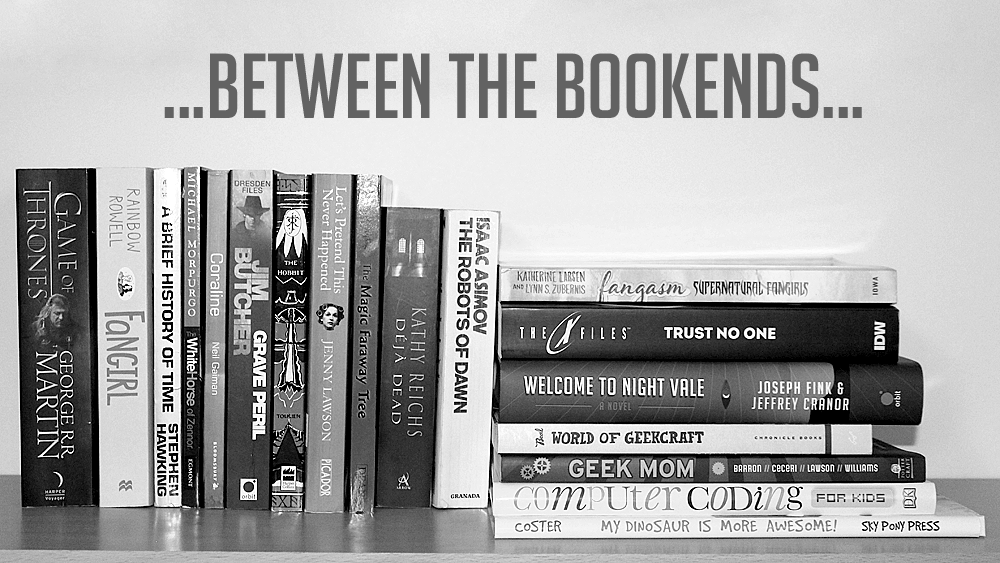
Every so often, I happen across a book I wish I could send to a younger version of me. I want to send my younger self stories that say that being autistic is just another way to have your brain process information; stories that show me characters who aren’t punished or harassed for being queer; stories that involve powerful female characters going on daring adventures. Every year, I gain a few more books that would help my younger me; books I can give my daughters. Raven: The Pirate Princess is one of those books.
I first heard about Raven when I got the chance to meet Jeremy Whitley at Awesome-Con in early April. Both my kids have devoured and loved Princeless, which is probably Whitley’s best known work and is targeted towards middle grade girls. I adored Unstoppable Wasp in single issues and was livid when it was canceled before first trade numbers were even in. Raven is a spin-off from Princeless, and that I had not heard about Raven before this is criminal. This fantasy adventure comic caught my immediate attention on Whitley’s table; after glancing through the first few pages, my 10 year old sent me back to the table to buy the rest of the series immediately.
- Princeless – Raven: The Pirate Princess Book One: Captain Raven and the All-Girl Pirate Crew
- Issues #1-4 of Princeless – Raven: The Pirate Princess
- Writer: Jeremy Whitley
- Art, Colors, and Letters: Rosy Higgins & Ted Brandt
The character of Raven Xingtao was first introduced in Princeless: Book Three – The Pirate Princess. Adrienne rescues Raven from her tower; Raven thanks her by stealing Sparky, Adrienne’s trusty dragon, to capture a pirate ship from someone loyal to one of her brothers. She tells Adrienne that although the Xingtao pirating clan was originally headed by a woman and has always been matrilineal, her father inherited by virtue of being the only child. Raven has two brothers, and they convinced the Pirate King to imprison Adrienne in a tower – thereby allowing themselves to inherit. Freed from the tower, possessing her own ship, Book 3 of Princeless ends Raven and Adrienne going their separate ways; Raven is off to reclaim what is hers.
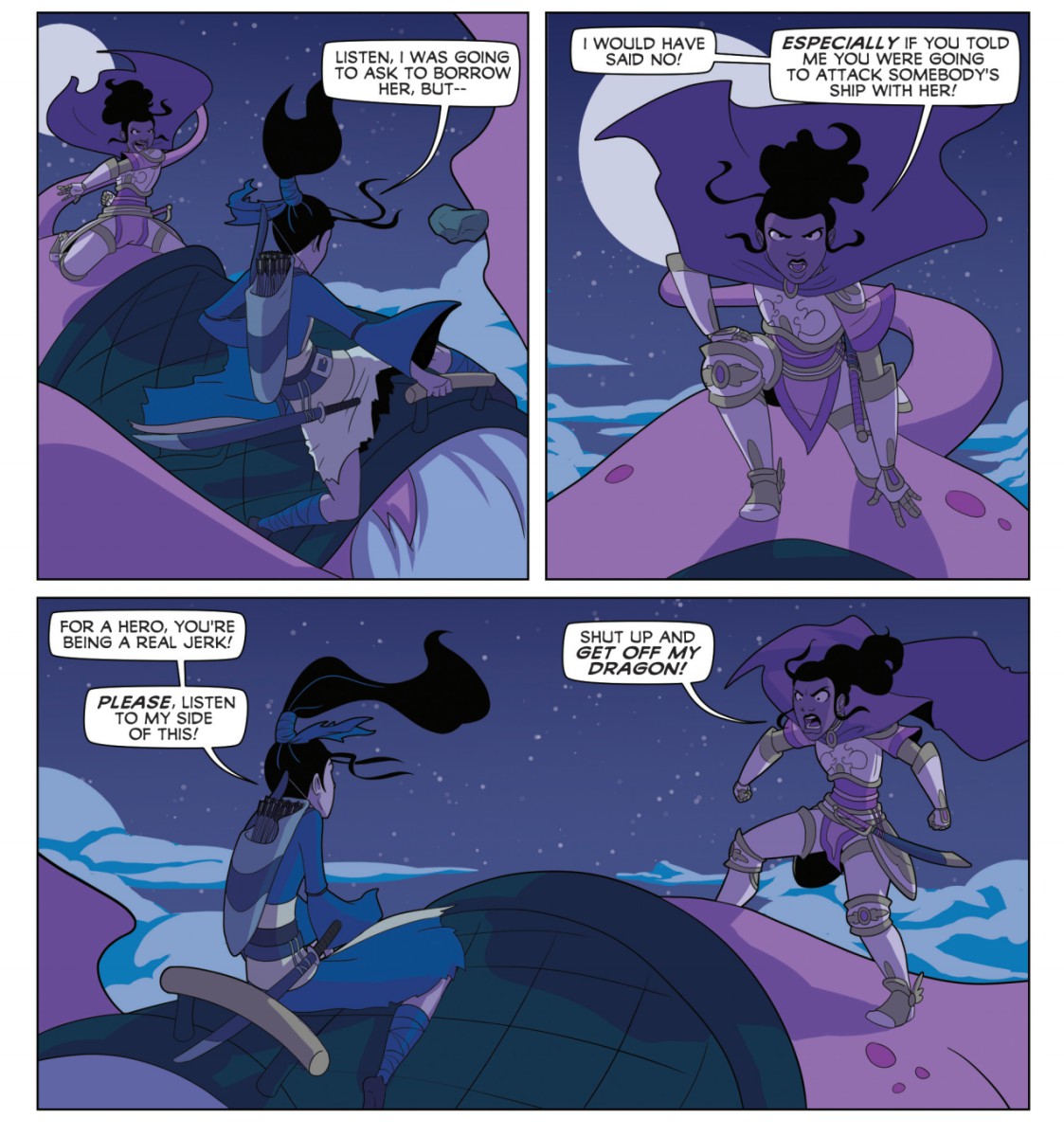
When Raven: The Pirate Princess begins, Raven has gone to a port city and is trying to figure out how to get a crew. Her father always just sort of had men around, she muses, and she has no idea how to find the right sort of men to continue her quest. Book One focuses on the story of exactly how Raven finds her crew.
In Princeless, Raven is the kind of secondary character who takes over the narrative. She is the first character to really shock Adrienne, from flat-out stealing Adrienne’s dragon, Sparky, to having no qualms about being seen naked. She is a swashbuckler, a dashing, daring pirate, and a little bit of a rogue.
As Raven takes over her own book, however, she becomes a more fully fleshed out character. We see Raven’s inexperience and doubts. She is surrounded by characters who are just as competent as she is, albeit in different ways; with this more level playing field, we get to see much more of her personality.
‘Raven: The Pirate Princess’ Explores Femininity
One of the frustrating things that happens all too often when men try to write younger female characters is that books end up with very narrow concepts of what it can to be feminine. Girls are feminine or powerful, but not both. Women have to be wearing grimy tanktops in a post-apocalyptic world to be taken seriously, and even those women are often softened and made acceptable to a male audience by having them interact with children, the dirt artfully arranged on her face so as not to detract from her 20-something white default Hollywood beauty. Both Ripley in Aliens and Jyn in Rogue One are examples of this.
In Princeless, Whitley shows a range of feminine characteristics, but that range is often limited by the story being Adrienne’s. Adrienne is very frustrated with typical femininity; she dislikes one of her sisters, for example, because her sister is pretty and doesn’t do anything, but gets more attention than Adrienne does. Adrienne’s story is a quest for identity, often by shedding the preconceived societal notions within herself through her interactions with her sisters. But she doesn’t know herself yet, just what she doesn’t want to be.
But in Raven, Whitley creates a more ensemble cast, allow himself to vary the personalities and feminine identities of his characters. From Whitley’s essay at the end of Book 4:
I wanted [Raven] to be surrounded by queer women of every shape, size, and ethnicity that identified as any number of things. In the crew, we have characters who identify as lesbian, bisexual, demisexual, asexual, and even one dealing with questions about their gender. It was important that we represent a wide spectrum of women not just for the sake of representation…but to show that Raven and those around her have built a community for themselves where they’re among other queer women who accept their identities as they present them.
The cast in Book One includes:
- Raven, a girl with a Chinese surname and East Asian features. She is mechanically inclined, an experienced sailor, and has a take-charge personality. She knows what she wants and has no reservations about going after it.
- Sunshine, a half-elf girl who is a dancer at a local tavern. She dresses in both pants and shirts that allow her to fight in fierce hand to hand combat and revealing dresses for her performances. She takes no crap from anyone.
- Jayla, a young black girl who is a chemist, and who proclaims herself to be the crew’s Chief Demolitions Officer. She has little patience for anything that gets in the way of her scientific exploration, or for explaining herself to people who can’t keep up with her intellect. She fights with her father, but doesn’t hesitate to use dramatic action to save her family’s livelihood. She doesn’t yet have much sense of the consequences of her actions.
- Katie, a tall girl with bright blonde hair. She is broader and bigger than all the other characters; in Book One she is described as chubby, but it’s worth noting that her weight is presented inconsistently in the following books. In Volume 2, she is mostly shown in a tank top with pronounced and very fit musculature; in later issues she is again drawn with a more rounded figure and has storylines that discuss and contend with her weight. She has a strong sense of honor and duty and a capacity to organize those around her, whether they’re part of her book club, her gaming guild, or the new crew where she serves as first mate.
- Ximena, a short, busty girl who was Raven’s best friend on the Pirate King’s ship for years. She is fierce and angry at Raven’s perceived betrayal in their shared past, and doesn’t hesitate in demonstrating those feelings. She is a map maker and a passionate astronomer while also being fashionable and concerned with her appearance.
When creating a cast this diverse, it would have been easy for the book to feel like someone was playing diversity Bingo: a Black girl, a Latina girl, a Chinese girl, a lesbian, a pretty girl, a tough girl. The difference is all a matter of nuance; specifically, that there is nuance. Each girl is drawn and written more carefully, giving each of them an individual feel that makes them their own unique character, rather than relying on stereotypes.
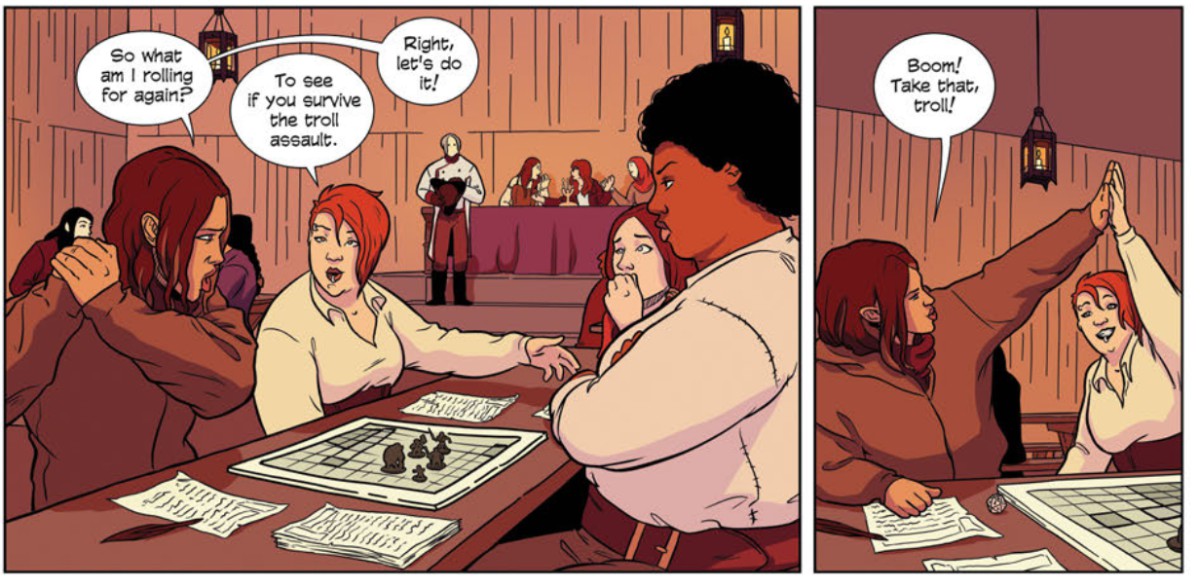
None of this would be possible without the art, which is an absolute treat for the eyes. This isn’t just because of what it does, but what it lacks. The characters are drawn with diverse body types allowing for an element of character that is rare for me to see in comics. It lacks the male gaze staging, impractically skimpy clothing, balloon-bod (sorry George, I still love New Teen Titans, but I need this to be the exception, not the rule!), but it also drawn in a way which keeps the characters grounded. Their clothing, posture, and facial expressions were all given a non-sexualized focus; each element gave me a sense of personality for each character. Yes, a number of the girls are pretty, and Raven does stare at Sunshine and Ximena, but it’s a character moment, showing how she was seeing them and what she was feeling. Even in that, it wasn’t cheesecake.
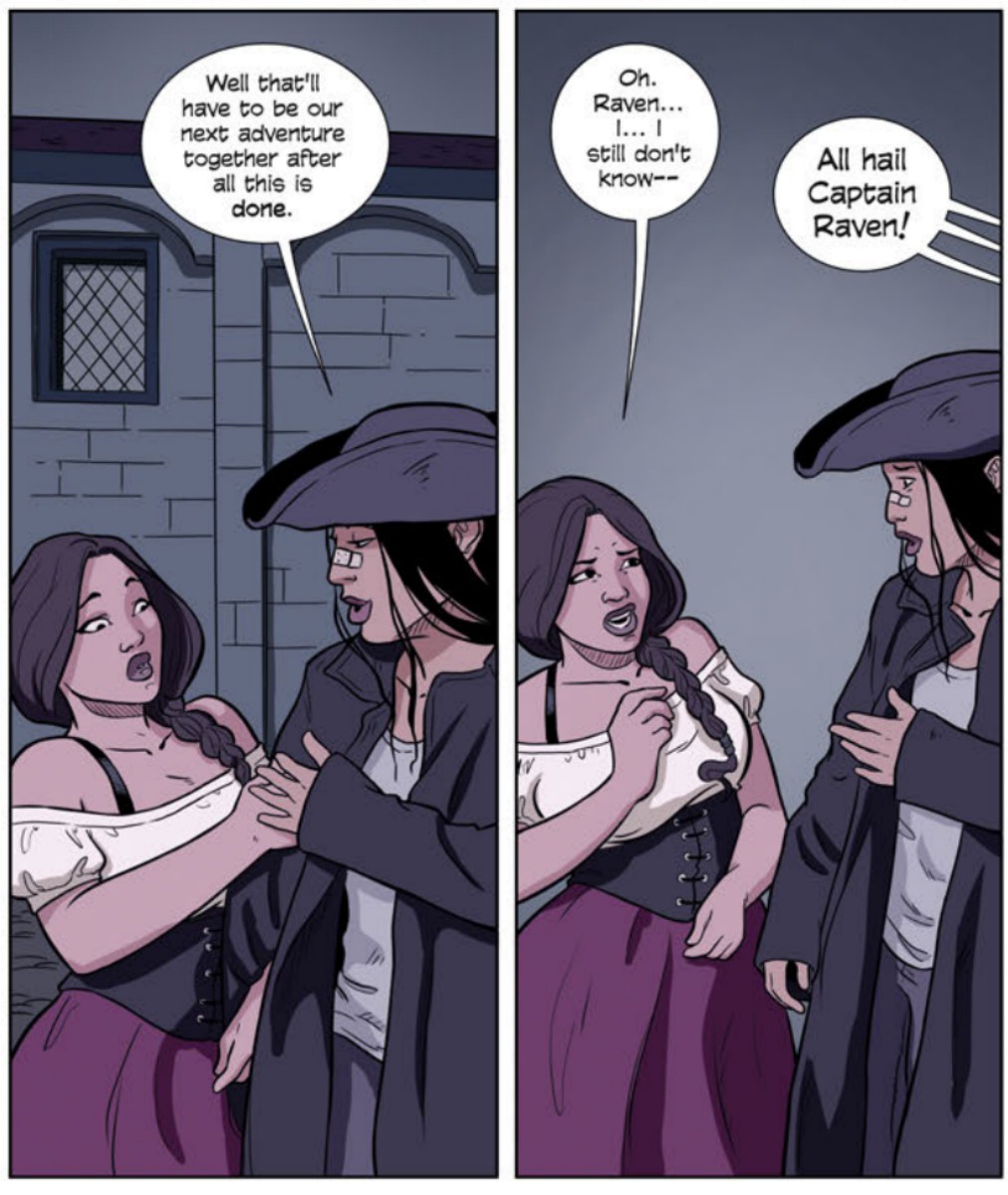
Higgins and Brandt created a sense of action, kinetic motion, emotional expressiveness, and a strong sense of place. I found myself applauding their work throughout the comic. There are times when I wince and shrink away from the page as I see the way women are drawn in comics. In Raven, I felt welcome and comfortable. That’s a rare feeling for me, especially in adventure comics.
Queer Representation
Whitley has stated in interviews that Raven is a lesbian. With this knowledge, I could easily see her sexuality in the gaze in Princeless, though it is definitely not as explicit. In Book One of Raven, her identity is still conveyed primarily through the gaze of the book; when another female character kisses Raven full on the mouth, she seems surprised by the kiss, but not the kisser. She has a relationship with another character that appears to have developed romantic overtones. When a third character says Raven needs to learn to cook if she wants to get a man, Raven shrugs it off by saying it’s not really a concern for her.
But what really makes this book shine in terms of representation is that no one cares. When Raven is kissed on the street, no one stares. Raven doesn’t look around nervously, pull her hat down low, and duck out of the street to avoid potential harassment. When Raven tells Cookie that finding a man isn’t a concern of hers, no one really notices or reacts. When Katie and the others realize that Raven is incredibly nervous about going to Ximena’s map shop, they question who Ximena is to her, but not in a way that sexualizes or romanticizes the relationship.
Queer acceptance is built into Whitley’s world in a way that makes my heart sing. LGBT narratives are infinitely more common now than they were when I was growing up, but there are still few that don’t mirror the world’s homophobia and transphobia. With good reason; queer kids are still at an absurdly high risk of self harm or suicide than their cis straight peers. Showing our youth how to navigate those terrifying situations is meaningful and important.
To be perfectly clear, there are great comics being written by women that are targeted towards this age group; DC Fontana’s work on DC Superhero Girls and Hope Larson’s on Goldie Vance are just two examples. I’m not in the business of handing out ally cookies for representation, but I’m also pleased by good writing and good representation where I can find it, especially when it’s clear that the author is willing to do the work to make the representation as good as possible. From Whitley’s essay at the end of Raven’s Book Four:
I am, after all, a straight white cis man writing a whole crew of diverse queer women. That’s a responsibility I take very seriously. I have consulted with a number of queer women from around the LGBTQ community to make sure that I’m not walking blindly into issues that I’m not aware of. I’ve listened, I’ve taken advice, I’ve changed the text of the book.
While helping our kids find ways to survive a world that sometimes seems dedicated to crushing them is crucial, but so is creating worlds where queer kids see that they can be accepted and loved without their identity being either hidden or exposed. Fantasy and science fiction are the perfect vehicles to make that happen; because the author is building the world from the ground up, they can imagine what a world could be like without racism, sexism, or homophobia. Raven and her crew do tangle with racism (specifically against elves) and sexism (in many different ways), but by the end of Book One, at least, Raven and her crew exist in a world free from homophobia and transmisogyny. These issues create exactly the world I wanted – and needed – when I was a queer kid trying to figure out who I was and how to navigate the world.
Really, Really Funny
Whitley has always had a way with humor; his dry sarcasm makes me smirk, but he doesn’t hesitate to create big laughs as well. He also leans into pop culture moments and modern references that take the book away from the erudite tone that high fantasy can sometimes take on. For example, there are:
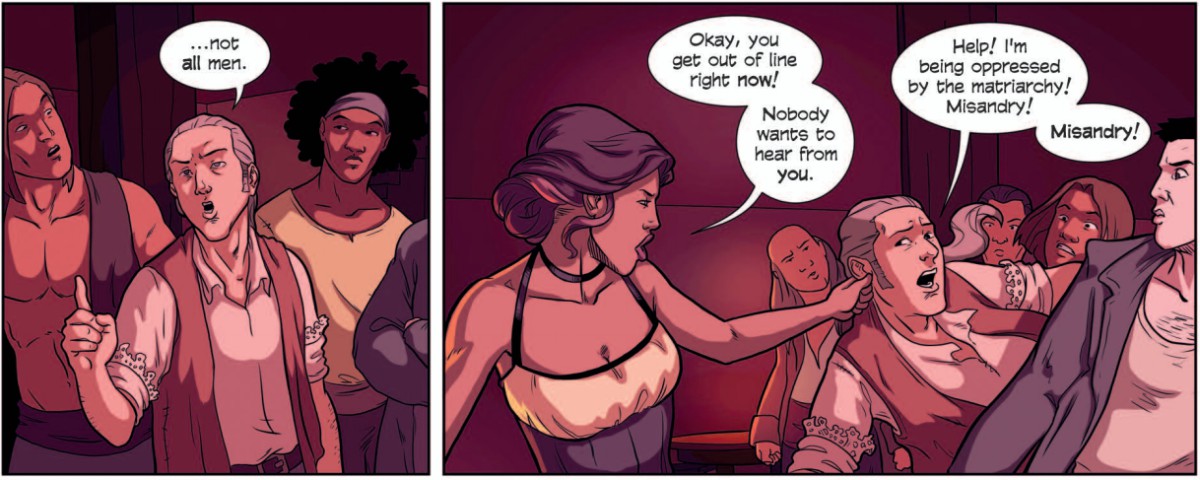
Not All Men references

And pointed references to the stupidity of the “fake geek girl.”
My Takeaway from Raven: The Pirate Princess
While Princeless is targeted towards middle grade readers (roughly 8 to 12 year olds), Raven: The Pirate Princess skews just a little older. Raven herself is 17, and the design of the book is just a little more adult. The lettering is smaller, there are more panels per page, and more happens in each panel. The humor is more likely to rely on sarcasm or modern references. It’s a rare comic that can make a Not All Men joke and make me belly laugh instead of roll my eyes. There’s nothing in Raven that would keep me from giving it to my 7-year-old, but I don’t think she’d like it as much as my 10-year-old does.
One of the best parts of ensemble casts is that every reader can choose the entrance character who they most relate to. For me, that character is Katie. Katie is always a little too big for the room she’s in. She’s broad and heavy. I imagine her having a voice she deliberately softens because she spent her childhood being told not to be so loud. Her language is more formally constructed than that of other characters. She recites a code of honor to Raven, and seems to take special care to act deliberately in all things – the act of someone told to keep themselves under control far too often. There’s one particular scene that causes me to read her as very autistic: when she tries to tell Raven about the group of women she knows, she goes through a long list of things that the group has been and done before remembering to point out that they’re fencers and survival scouts.

When Katie takes Sunshine to her Guild – an awesome portrayal of the kind of community of women I’ve always wanted to belong to but never quite found – she goes before the Triumvirate to get permission to address the Guild. The Triumvirate, let’s note, is made up of a girl in a head scarf, a classic nerd girl in glasses, and a girl with long hair and a renaissance faire style dress.
The Triumvirate confers, and then tells Katie that it’s not for them to tell her to stay where she is. They say that she should address the women and see who might be interested in joining a pirate crew. Katie asks what if she can’t do it. They reply:
“Go be your own hero, Katie…If you fail, do it beautifully and passionately.”
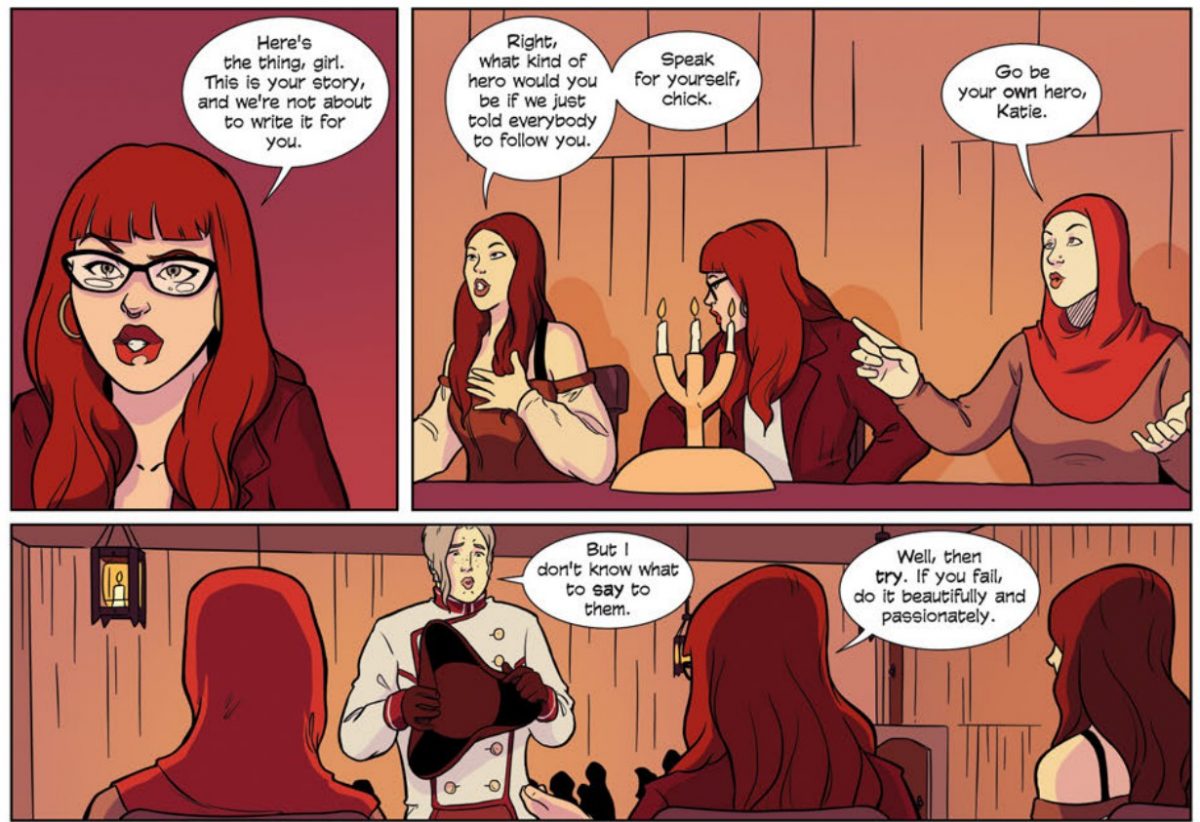
When I was a kid trying to understand how to survive marginalizations in an unfriendly world, my biggest fear was taking risks. Risks meant exposing my true self in ways that meant I might be ostracized or beaten or worse. I was 18 years old when Matthew Shepard was killed for being gay. That single incident kept me in the closet for three more years. I was 37 years old before I realized that I could be the hero I was waiting for in my life.
The women who appear to be closest to Katie in this first volume see her for who she is. They encourage her to take the risk of reaching for her dream. And, at least for me, there’s a sense that if she does fail, they will be there to help her pick up the pieces. That belief alone would have changed my entire childhood – and adult life – for the better.
I am glad I got to meet Jeremy Whitley at Awesome-Con; I’m glad I found out about this book and got to buy it and get it signed; I’m incredibly glad I bought the next three volumes at the same time. This is one of those books I will be delighted to buy in both single issue and trade, because this book deserves my full-throated support.
If you’re interested in comics that center girls and support a diverse understanding of what being a girl can mean, I could not possibly recommend this book more.




